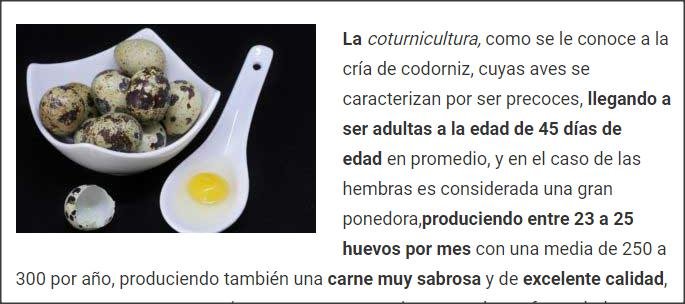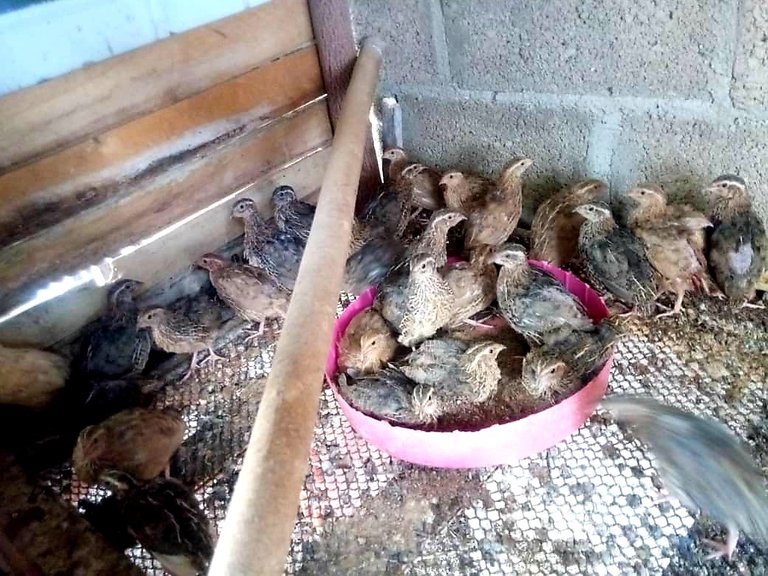
Buenas tardes, apreciados lectores, les saluda Gledys. En esta oportunidad quiero compartir con ustedes, mi experiencia personal en cuanto al manejo y cría de las codornices. Está actividad se conoce con el nombre de: coturnicultura. Existen varias razas, entre ellas a citar: la japónica - japónica, la coreana, la canadiense, y la faraónica. Unas, se usan con fines de producción de huevos y otras, con fines cárnicos.
Sus bondades alimenticias se conocieron por primera vez, en el continente asiático, China y Japón. En los tiempos de la antigüedad, sólo eran criadas y consumidas (huevos y carnes), por los Emperadores puestos que son consideradas fuentes de proteínas y nutrientes, excepcionales,para el ser humano y; además consideradas manjar para reyes. Posteriormente fueron llevadas, al continente europeo y, de allí, con la colonización de los españoles, a todo el Continente americano, siendo Argentina, pionera en su consumo.
Es necesario resaltar, que la raza japónica - japónica es la de mayor producción de huevos, y; el resto de las razas como productoras de carne. La coturnicultura, es considera una actividad económica altamente rentable. Porque es partir de los 45 días de nacidas, que se empieza a recuperar el capital monetario y mano de obra invertido. Labor que puede ser desarrollada por personas o grupos familiares de bajos recursos y con poca disponibilidad de espacio (no ameritan espacios físicos grandes para su crianza) y son de fácil manejo.
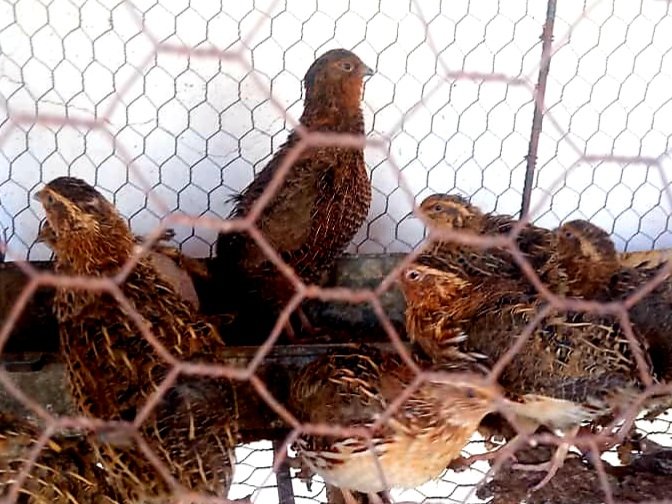
La cría de estás aves se puede llevar a cabo en jaulas colocadas en forma de módulos o baterías que miden: 1 metro de ancho por 50 centímetros de profundidad y 25 centímetros de alto, donde caben 40 ejemplares por jaula. Considerando que deben gozar de buenos comederos y bebederos, poniendo particular énfasis, en el suministro de agua, constante limpia y pura, y; que no padezcan de sed, para así; favorecer la mayor producción de huevos posible.
Estos animales, comienzan sus primeras posturas alrededor de los 45 días de edad, alcanzando su madurez sexual, a partir de los 2 meses, con un porcentaje de 70% y 80% diario en la producción. Su vida útil está estimada hasta los 18 meses aproximadamente. Comparto a continuación, características sobresalientes entre macho y hembra.
La hembra puede llegar a pesar hasta 130 gr. El color del plumaje en el pecho, es de un color blanco con un puntillado negro y los cachetes o mejillas son color crema pálido o pálidos. Ella, es de mayor tamaño en comparación con el macho. El macho se distingue, por su peso, siendo unos 20 gr menos con respecto a la hembra, es de menor tamaño y, el color de su plumaje en el pecho, garganta y mejilla es marrón oscuro o color café.
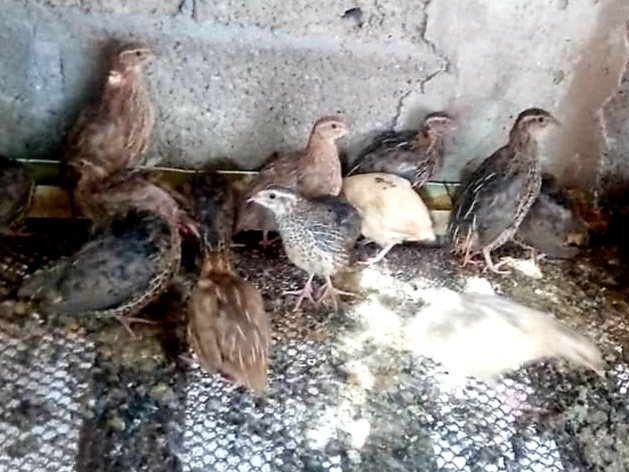
El macho emite un sonido o canto característico y singular en él, a partir de los 2 los meses de edad. El área de la cloaca (área genital), de éste ejemplar se observa abultada, con poco plumaje alrededor y de un color rosado intenso.Y, al ejercer presión en dicha zona, es expulsado un líquido blanco espumoso, conocido como esperma.
Es en ésta etapa (madurez sexual) que el macho usa su canto, para estimular el celo en la hembra. Debido al proceso de domesticación,la codorniz, no se enclueca, por tanto; para multiplicarlas, hay que recurrir a la incubación. Los huevos eclocionan entre los 14 y 17 días. Los polluelos reciben el nombre de Cotopollos, en sus primeros días de vida.
Los cotopollos deben criarse a una temperatura de 35 grados centígrados, dentro de los primeros 18 días de nacidos. Considerando, el uso de luz artificial en el día y la noche. Este proceso es conocido como levante. En este tiempo, deben alimentarse, con alimento procesado iniciador, que tenga como mínimo un 24% y 26% de proteínas crudas.
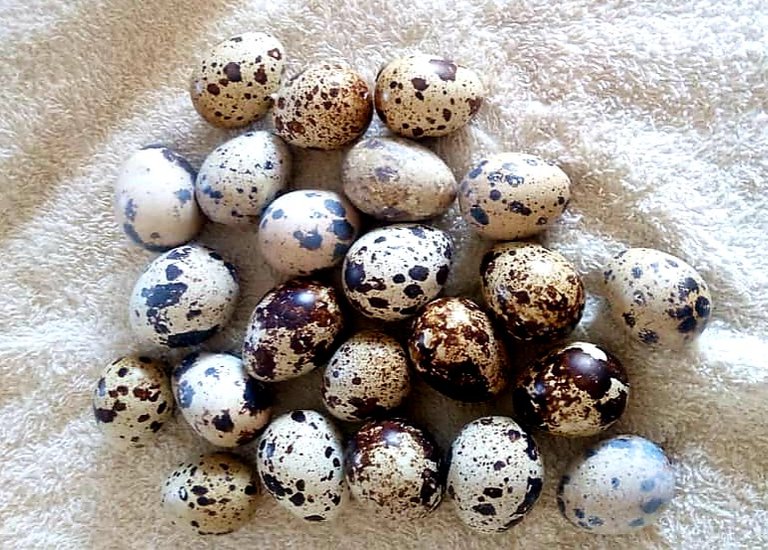
Posterior a este lapso de tiempo, y; hasta los 42 días, entran en el ciclo de prepostura. Donde se le comienza a suministrar alimento: ponedora, cuyo porcentaje de proteínas crudas alcanza los 18%. Recomiendo, por experiencia : Que en el periodo de puesta, se sugiere administrar alimento con un 24% mínimo de proteínas.
El huevo de la codorniz, tiene ventaja, con respecto al de la gallina, puesto que posee, un 0,02% de colesterol y, el de la gallina un 7%. El huevo de codorniz, contiene 5 a 7 veces más, hierro y vitaminas que el huevo de gallina. Por estás propiedades, se recomienda su consumo, en personas con hipertensión arterial, hipercolesteronemia, anemias, enfermedades debilitantes o carenciales, por déficit en la absorción de vitaminas, hierro y proteínas, es decir en casos de avitaminosis.
Existen países, en los cuales la cultura gastronómica del consumo de este rubro, es de alta incidencia. Este factor se convierte en una característica favorable para el productor, al momento de colocar sus productos en el mercado,por la amplia demanda de los mismos. Pero también hay países como Venezuela, donde existe cierto grado de desconocimiento y poco consumo del mismo. Señalamiento que hago, en aras de incentivar al emprendimiento, cría y manejo, de éste renglón pecuario. Con ello, estaríamos contribuyendo, en mejorar la alimentación y calidad de vida de una nación. En generar fuentes de trabajo, e ingresos, desde el hogar. Y, de esta manera, establecer la cultura de la producción y el trabajo independiente. Me despido por hoy, su amiga Gledys.
All photographs are my own/Todas las fotografías son propias

